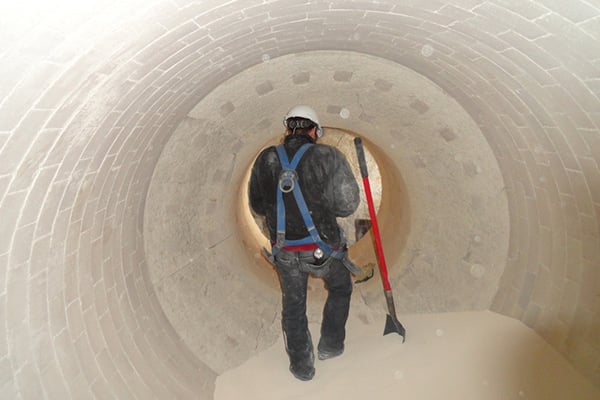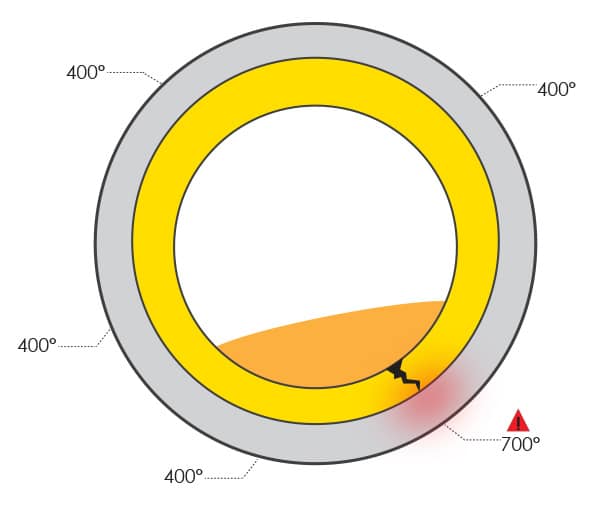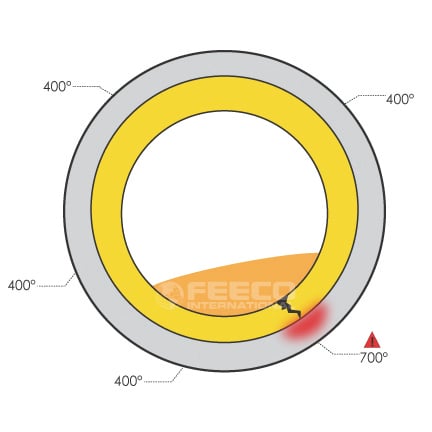The refractory in a direct-fired rotary kiln is a crucial component, serving to both protect the shell of the drum and combustion chamber from the high interior temperatures, and to minimize heat loss. As a result, protecting refractory is not only critical to promoting optimal efficiency, but also to maintaining and prolonging the life of a rotary kiln.
Refractory failure has the potential to cause catastrophic consequences if left unaddressed. Significant downtime, extensive maintenance or even total kiln replacement, as well as lost production, can all result from refractory that has been allowed to degrade.
Once rotary kiln refractory is installed and in use, taking the extra steps to protect it are of the utmost importance.
Causes of Rotary Kiln Refractory Damage & Failure
A well-installed, high-quality refractory can have a lifespan of many years. There are several factors, however, that have the potential to cut refractory life short if not properly monitored and managed – the most common of which, are summarized below.
Kiln Cycling
The most common source of refractory failure is what is called cycling. Cycling is simply the heating up and cooling down of a rotary kiln during shutdowns and startups.
Each time the rotary kiln is heated, the refractory expands with the drum. As the kiln cools down, the refractory retracts. If a kiln is constantly being heated up and shut down, the refractory can easily become stressed, causing cracks. Similarly, cracks can also occur from heating or cooling the kiln too quickly, which also stresses the refractory.
While cycling is unavoidable to some extent, it should be minimized as much as possible to maintain the integrity of the refractory.
Chemical Incompatibility
Another common source of refractory failure is chemical incompatibility. Refractory is not designed to be able to withstand certain chemicals. This is commonly seen with chlorides.
Chlorides can aggressively attack refractory, causing excessive wear because of their corrosive nature. When these chemicals are identified up front, refractory can be designed to handle such aggressive corrosion as best as possible. However, if not prepared for in the initial design, chlorides or other corrosive materials can quickly degrade refractory.
Abrasivity
Similarly, failure can also occur when a rotary kiln is used for something the refractory was not designed for, particularly when it comes to abrasive materials.
Like corrosion, refractory can be designed to combat an abrasive material, but if not prepared for in the initial design, can have devastating effects. For example, when compared to castable, brick refractory wears less in the presence of an abrasive material and may be the refractory of choice when working with an especially abrasive material.
For these reasons, feedstock analysis is an important component in maintaining rotary kiln refractory. Any change in feedstock should be accompanied by a thorough analysis to ensure minimal damage.
Tramp Material
In addition to the factors listed above, tramp material, or material not meant to enter the kiln, along with material clumps, have the potential to cause damage to a kiln’s refractory.
Tramp material can be harder to detect, but in some cases may be indicated by unusual auditory cues.
Maintaining Rotary Kiln Refractory
Signs of refractory damage or failure can be difficult to recognize. And since damage can accelerate quickly, regular monitoring is critical to catching problems early. Any potential signs of damage should be addressed immediately to avoid escalation of an issue to a more severe situation.
Routinely Inspect Refractory
Refractory should be regularly inspected as part of the overall preventative maintenance program. When permissible, operators or a customer service engineer from the original equipment manufacturer should inspect the refractory from the inside of the drum to check for the start of any potential cracks or wear while the unit is shut down.
Castable refractory can exhibit hairline cracks over time. If anchors are not properly installed, these cracks can get bigger and allow portions of refractory to fall out. Similarly, these hairline cracks can become bigger, trapping material and creating hot spots.

A FEECO Customer Service Engineer inspects the refractory inside a rotary kiln.
Check Shell Temperature
While not a guaranteed method of detection, refractory problems can also be detected through regular monitoring of the drum shell temperature. This can be done by picking a spot on the rotary kiln shell and holding a temperature gun in place. As the rotary kiln rotates, that spot should be the same temperature for the entire circumference of the shell. For example, a reading of 400º, 400º, 700º, 400º reveals a hotspot on the shell, indicating a failure in refractory. Left unnoticed, this could lead to severe damage to the rotary kiln shell.
In addition to circumference temperature being the same in a given location, the kiln should also exhibit a gradual shift in temperature from one end of the kiln to the other, rather than a drastic or sudden change.

Refractory failure can have disastrous results. Even a small crack can allow heat to reach the rotary kiln shell. It is important to routinely check the exterior temperature of the rotary kiln shell, ensuring that the temperature is consistent for the entire circumference of the drum.
Conclusion
Regularly monitoring and maintaining the refractory in a direct-fired rotary kiln is essential in achieving maximum efficiency and prolonging the overall life of the rotary kiln. Various factors can cause failure and early detection is critical to avoiding excessive downtime, maintenance or replacement costs, and lost production.
FEECO is a leading manufacturer of custom rotary kilns. We also provide a comprehensive range of parts and service support, including annual inspections, to help keep rotary kilns running optimally. For more information on preventative care for rotary kilns, contact us today!


